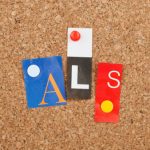 Amyotrophic lateral sclerosis (ALS) pain is often an underestimated and neglected symptom. ALS is a fatal neurodegenerative disorder, which is characterized by the progressive loss of motor neurons, muscle wasting, and respiratory dysfunction. Secondary symptoms, such as pain, can arise, causing additional difficulty in a patient’s life and further limiting one’s abilities.
Amyotrophic lateral sclerosis (ALS) pain is often an underestimated and neglected symptom. ALS is a fatal neurodegenerative disorder, which is characterized by the progressive loss of motor neurons, muscle wasting, and respiratory dysfunction. Secondary symptoms, such as pain, can arise, causing additional difficulty in a patient’s life and further limiting one’s abilities.
Pain in ALS is not a primary symptom, but many patients still experience it. There is a lack of research with regards to pain and ALS, thus limiting treatment options available. More research is required in the area of pain and ALS in order to improve treatment options for patients.
Advertisement
Pain is an unpleasant sensation or emotional experience in response to a noxious stimuli, tissue injury, or trauma. Pain can be acute or chronic, depending on its cause. There are different types of pain experienced in ALS, including musculoskeletal pain, muscle cramping, and spasticity.
Musculoskeletal pain can occur in the back, legs, arms, shoulders, and neck, and is often caused by inactivity or the presence of inflammation. This type of pain is commonly a secondary symptom from muscle atrophy and loss of muscle tone. Bones, nerves, tendons, ligaments, joints, and nerves can become damaged in ALS, thus contributing to pain.
Muscle cramping occurs most frequently in the early stages of ALS. It can occur in any muscle and can be quite painful. Muscle cramping is often experienced months prior to muscle weakness, but unfortunately it is often overlooked as a symptom and not made part of diagnosis. Muscle cramps may be caused by cold temperatures or a decrease in circulation due to a muscle being kept in the same position for an extended time period.
Spasticity is an increase in tonic stretch reflexes. It occurs due to an abnormal proprioceptive input in the spinal cord. In ALS, spasticity is caused by the changes in the upper motor neurons of the motor cortex. Spasticity alone isn’t generally painful, but it can trigger painful events, such as muscle cramps or muscle fatigue.
Pain therapies for amyotrophic lateral sclerosis (ALS)
Treatment for pain associated with ALS can be complicated, as each person may react differently to different treatment options. Often treatment is combined with different approaches to get the best well-rounded form of treatment for the patient. This combination may target nutrition, respiratory factors, psychology, and motor function, to name a few.
A large factor contributing to pain in ALS has to do with inactivity. Hence, treatment may begin with physiotherapy as a way to get the patients moving in order to reduce pain. Medications, too, may be prescribed to work with physiotherapy in order to further reduce muscle cramping and spasticity. Resistance exercise has been shown to help slow down the progression of functional decline, and joint mobilization can aid in reducing musculoskeletal pain, spasticity, and cramping.
Medications and supplements are administered mainly to reduce muscle cramping, and there are some medication options to help reduce spasticity as well.
As ALS progresses, pain can become worse, and anti-inflammatory medications may be prescribed along with opioids and narcotics. The latter are used in extreme cases and should only be administered by a doctor, as they bring along many unwanted side effects.
Treatment options for amyotrophic lateral sclerosis (ALS)
 In 1995, the FDA approved the first ever drug to help treat ALS – riluzole. The drug is intended to reduce damage to motor neurons by reducing the release of glutamate. In clinical trials, riluzole was found to extend survival of ALS in many patients. Furthermore, the drug helped to extend the time needed for a ventilator. Damage that has already been done cannot be reversed, but the drug can work to slow down progression of future damage.
In 1995, the FDA approved the first ever drug to help treat ALS – riluzole. The drug is intended to reduce damage to motor neurons by reducing the release of glutamate. In clinical trials, riluzole was found to extend survival of ALS in many patients. Furthermore, the drug helped to extend the time needed for a ventilator. Damage that has already been done cannot be reversed, but the drug can work to slow down progression of future damage.
There are other treatment options intended to help relieve the symptoms associated with ALS. Like pain therapies, treatment options are often best done when in conjunction with different methods. Doctors, physical therapists, pharmacists, occupational therapists, nutritionists, and social workers often work together to help treat and improve quality of life for ALS patients.
The treatment team works to assist ALS patients’ lives in different ways. Doctors will often prescribe viable medications, physical therapists help maintain muscle and movement, nutritionists work to provide food and diet assistance, and a social worker assists with emotional, medical, and financial challenges.
ALS can affect many aspects of a person’s life, and thus it’s important that each of those aspects is taken care of with assistance of professionals. ALS can greatly impact a person’s life. As the disease progresses, the patient’s abilities become fewer, and so additional support is required. Although there is currently no cure for ALS, fundraising efforts continue to push for research in hopes for a cure.
Related Reading:
ALS risk affected by BMI, dietary intake, and alcohol consumption
Amyotrophic lateral sclerosis (ALS) risk is affected by body mass index (BMI), dietary intake, and alcohol consumption. Although the exact cause of ALS is still not understood widely, dietary intake is a modifiable factor, which may play a role in ALS. Researchers from the University Medical Center Utrecht used a 199-item food frequency questionnaire in order to study dietary intake and the risk of ALS. Continue reading…
Advertisement
Cerebral palsy, ADHD, autism, and epilepsy may often overlap in older children
Cerebral palsy, ADHD, autism, and epilepsy may overlap in older children. The study that uncovered the findings looked at over 700,000 children from Norway and revealed that ADHD, autism, and epilepsy had significant occurrences by 11 years of age. Cerebral palsy was also found in high occurrence in children over the age of four. Lastly, boys had a higher risk of these conditions, compared to girls. Continue reading…
Sources:
https://www.ninds.nih.gov/Disorders/Patient-Caregiver-Education/Fact-Sheets/Amyotrophic-Lateral-Sclerosis-ALS-Fact-Sheet
http://www.ninds.nih.gov/disorders/amyotrophiclateralsclerosis/detail_ALS.htm
